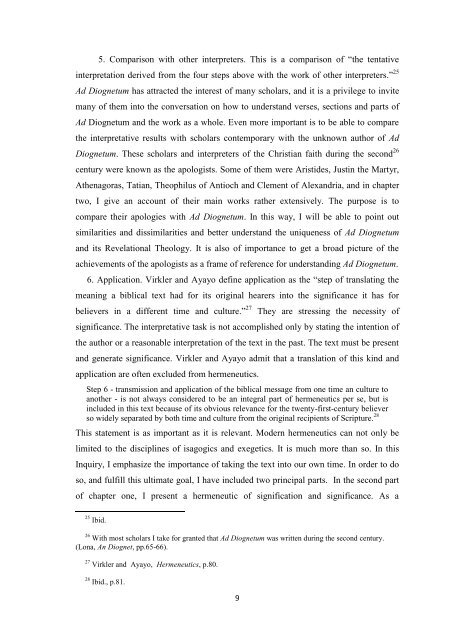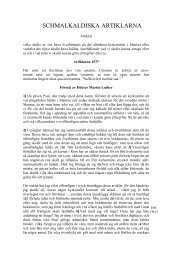MYSTERY REVEALED
MYSTERY REVEALED
MYSTERY REVEALED
You also want an ePaper? Increase the reach of your titles
YUMPU automatically turns print PDFs into web optimized ePapers that Google loves.
5. Comparison with other interpreters. This is a comparison of “the tentative<br />
interpretation derived from the four steps above with the work of other interpreters.” 25<br />
Ad Diognetum has attracted the interest of many scholars, and it is a privilege to invite<br />
many of them into the conversation on how to understand verses, sections and parts of<br />
Ad Diognetum and the work as a whole. Even more important is to be able to compare<br />
the interpretative results with scholars contemporary with the unknown author of Ad<br />
Diognetum. These scholars and interpreters of the Christian faith during the second 26<br />
century were known as the apologists. Some of them were Aristides, Justin the Martyr,<br />
Athenagoras, Tatian, Theophilus of Antioch and Clement of Alexandria, and in chapter<br />
two, I give an account of their main works rather extensively. The purpose is to<br />
compare their apologies with Ad Diognetum. In this way, I will be able to point out<br />
similarities and dissimilarities and better understand the uniqueness of Ad Diognetum<br />
and its Revelational Theology. It is also of importance to get a broad picture of the<br />
achievements of the apologists as a frame of reference for understanding Ad Diognetum.<br />
6. Application. Virkler and Ayayo define application as the “step of translating the<br />
meaning a biblical text had for its original hearers into the significance it has for<br />
believers in a different time and culture.” 27 They are stressing the necessity of<br />
significance. The interpretative task is not accomplished only by stating the intention of<br />
the author or a reasonable interpretation of the text in the past. The text must be present<br />
and generate significance. Virkler and Ayayo admit that a translation of this kind and<br />
application are often excluded from hermeneutics.<br />
Step 6 - transmission and application of the biblical message from one time an culture to<br />
another - is not always considered to be an integral part of hermeneutics per se, but is<br />
included in this text because of its obvious relevance for the twenty-first-century believer<br />
so widely separated by both time and culture from the original recipients of Scripture. 28<br />
This statement is as important as it is relevant. Modern hermeneutics can not only be<br />
limited to the disciplines of isagogics and exegetics. It is much more than so. In this<br />
Inquiry, I emphasize the importance of taking the text into our own time. In order to do<br />
so, and fulfill this ultimate goal, I have included two principal parts. In the second part<br />
of chapter one, I present a hermeneutic of signification and significance. As a<br />
25 Ibid.<br />
26 With most scholars I take for granted that Ad Diognetum was written during the second century.<br />
(Lona, An Diognet, pp.65-66).<br />
27 Virkler and Ayayo, Hermeneutics, p.80.<br />
28 Ibid., p.81.<br />
9



